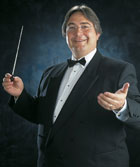Expert workshop - Section 3 - Entertainments
17-Feb-2006Dr. Robert Childs looks at Gilbert Vinter's great set work for the Third Section and finds that it will need a lot of care and attention.
 I: (Caprice)
I: (Caprice)
This can easily be over-blown. Keep it brilliant but not aggressive. Make a good crescendo in bar 4 & 5 (cnts). Look for the detail in the accents but don't over do them. Make sure the wood block isn't too loud in bar 12, you need to hear a crescendo and a fz at the end.
Bar 13 balance the trombones. Bar 16 make the crescendo work and find the detailed dynamics in bar 17 and 18. Between 20 and 30 lower the general dynamic to enable the accents to come through without becoming aggressive.
Always keep the music playful. If you have a good xylophone player use hard sticks if you don't use rubber ones! Bar 29 save some dynamic for the accents. Balance the bass and euph at 30. Be very careful to grade the dynamics between 33 and 40. At 47 change the style and consider your rubato wisely. Balance trombones and check the ensemble between cnt, bari and Bb bass. At 60 remember its only forte then 62 is fortissimo, but not over-blown.
Tight ensemble to finish.
II: (Elegy)
Keep this music flowing and don't over-do the rubato. Essentially this movement is sad music which needs to be phrased and balanced precisely. All the phrases have potential for well shaped expression.
This movement and the slow bit at the end of the 1st movement will probably win or loose the contest.
At 22 keep the music flowing and balance the hns and 2nd cnts. At 39 the music is only forte.
Better to have the last chord a little too loud than out of tune and not balanced.
III: (March)
The back row really need to blow against the mutes to achieve a good balance with the front row. Bar 6, measure the demis and bar 7 differentiate between the accents and non-accents.
The music that starts at bar 9 needs to be full of character and style. Bar 26 is difficult to balance, but you do need to hear the flg.
At 43 resist the temptation to play louder than forte and don't slow down. Bar 46 requires a substantial crescendo from the lower end.
Bar 58 is only forte, 59 is slower than 43!
Bar 66 needs a clean cut-off on the 3rd beat. Hear the trom gliss in the last bar.
Dr. Robert Childs















